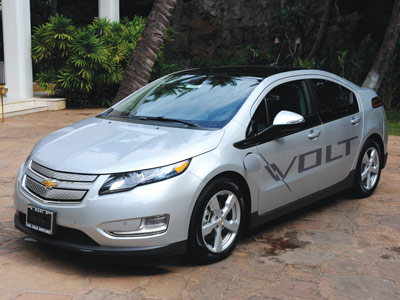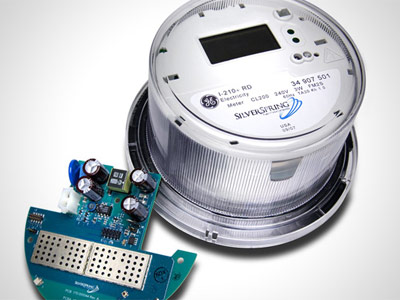Story by Teya Penniman
 Custom cars with yellow-and-black flame jobs, open-top cruisers, and brilliant-hued classics pack the Great Lawn of the University of Hawaii Maui College at a nighttime event highlighting the school’s auto technology program. Several-hundred car enthusiasts stand proudly by their rides, while bass lines and drums from a live band vibrate air and ground. I sit tucked into the darkened backseat of a Chevy Volt — one of only two electric vehicles (EVs) at the show — talking with a different kind of enthusiast. Unlike the hot-rod owners, who spend weekends and hard-earned cash on paint jobs and supersized mufflers, my host cares less about what’s on the outside than what makes this car go. Surrounded by the old-school party outside, it feels almost conspiratorial — a meeting with one of an elite club, plotting a revolution to change the existing power structure — literally, the energy that fuels our cars and keeps the lights on.
Custom cars with yellow-and-black flame jobs, open-top cruisers, and brilliant-hued classics pack the Great Lawn of the University of Hawaii Maui College at a nighttime event highlighting the school’s auto technology program. Several-hundred car enthusiasts stand proudly by their rides, while bass lines and drums from a live band vibrate air and ground. I sit tucked into the darkened backseat of a Chevy Volt — one of only two electric vehicles (EVs) at the show — talking with a different kind of enthusiast. Unlike the hot-rod owners, who spend weekends and hard-earned cash on paint jobs and supersized mufflers, my host cares less about what’s on the outside than what makes this car go. Surrounded by the old-school party outside, it feels almost conspiratorial — a meeting with one of an elite club, plotting a revolution to change the existing power structure — literally, the energy that fuels our cars and keeps the lights on.
Getting Maui off imported oil can’t come quickly enough. Even though foreign oil provides an estimated 85 percent of the island’s electricity, Maui’s relatively small market puts Maui Electric Company at the mercy of global price fluctuations in oil. Hawaii’s consumers feel the pain not only at the pump but every month with the highest electricity rates in the country.
Luckily for Maui, the revolution has an amazing cast of visionaries working to build a new energy future, including UH Maui College Chancellor Clyde Sakamoto. Sakamoto’s longstanding commitment to sustainability helped attract another key collaborator — the University of California at San Diego. There, a campus-based microgrid generates an astounding 92 percent of the electricity used by its community of 90,000 people, an accomplishment in process to be repeated on Maui.
Byron Washom, UC San Diego’s director of Strategic Energy Initiatives, says his campus couldn’t consider its efforts successful until it had replicated them at smaller and larger scales. The university began looking for another administration that shared its vision for sustainability and innovation. “Who do you select to be your best dance partner?”
The location could have been anywhere in the United States. But, Washom says, “We found that match in Clyde Sakamoto. Maui College happens to be one-tenth the scale of the UC San Diego campus in energy demand. And Maui itself is a hotbed of activities and demonstration projects for the country.”
Along with support from UC San Diego, a combination of industry participation and local leadership has Maui test-driving several innovative energy initiatives. The first project seeks to reduce the island’s dependence on fossil fuels for transportation by increasing the number of electric vehicles. Two other pilot projects are exploring how to make Maui’s electric grid “smarter” to improve energy efficiency and use more renewable resources. Maui, it turns out, is a vortex on the new-energy front, not just in Hawaii, but nationally, even globally. And our little parking spot on the Maui College campus is smack dab in the middle of it.
 Keeping the Love, Kicking the Oil
Keeping the Love, Kicking the Oil
My fellow passenger and navigator is Anne Ku, project director for the Maui Electric Vehicle Alliance, or Maui EVA. Ku’s challenge is to help develop a multiyear plan to get electric vehicles on the road along with enough charging stations to allow drivers to reach the next place to plug in before running out of volts. Ku is organizing fellow conspirators — public, private and nonprofit stakeholders — whose early commitment to promoting electric vehicles helped Maui College become the only university campus in the country to secure a $300,000 federal grant under the Department of Energy’s Clean Cities’ initiative.
“It’s a chicken-and-egg thing,” Ku says. “You need a certain critical mass of EVs before you can justify the expense of installing charging stations, but it’s hard to promote EVs without the right mix of charging options.”
You wouldn’t drive the backside of East Maui on an empty tank. EV drivers need a network of stations with both slow and fast chargers spread across the island to prevent running out of juice before reaching the next outlet. Ku’s job involves helping diverse but related interests raise chickens and start laying eggs at the same time. Maui EVA is focusing on infrastructure needs, policy issues, and visitor concerns, while engaging and educating island residents, businesses and organizations about electric vehicles.
Why go electric? Advocates of all-electric cars highlight the following benefits: zero emissions; charging options at home, work, and public locations; less maintenance than required for an internal-combustion engine; regenerative brakes that translate to less wear; and fuel-cost savings and reduced price volatility. As an incentive, Maui Electric Company offers a lower time-of-use rate to encourage EV owners to charge their vehicles during off-peak hours.
One of the best sources of support for electric vehicles comes from “early adopters” — people who are willing to use a new product or technology, even though all the problems and risks may not be worked out. An estimated fifty electric vehicles are cruising Maui’s roads. Ku says, “Every single person who owns an EV or who has driven one has nothing but praise.”
Like the Great Lawn gathering at Maui College, early adopters are holding their own rallies. Wailuku Heights resident Christine Andrews sponsored a house party to share information about electric vehicles. A dozen or so of the curious and the committed held a casual Q&A around two all-electrics and a plug-in/hybrid — hoods propped open, shiny power outlets laid bare — and talked about torque, mileage, price, models, and another term specific to electric vehicles: range anxiety. How far can you go from your base charging location before you run out of power? Built-in software and a handful of mobile apps help provide up-to-date information about the nearest charging stations, but Andrews needed to be sure she could make the uphill trek from home to her kids’ school in Upcountry Maui and back before making the commitment. She rented a Nissan Leaf from Bio-Beetle, the first car-rental agency to carry electric vehicles on Maui. After a month of test-driving, she purchased her own and is now a strong advocate.
Bumps in the Road
Despite all the buzz, electric vehicles aren’t without drawbacks, including a wait time to purchase one, range limitations, a slow charge, limited service options, and price. Solutions to a number of these issues exist or are in the works and reflect strong industry support. More than thirty different government agencies, businesses, and organizations are partnering to help make the Maui EVA project a success.
Local dealers like Jim Falk Motors, and car rental agencies like Bio-Beetle and Enterprise, have started bringing in more electric cars to meet demand. Slow charge times will become a nonissue as high-voltage (480V) charging stations come on line. Substantial rebate programs, like the federal government’s $7,500 tax credit, have eased the pain of high-priced electric vehicles. Early adopters have another benefit at least through 2012: free charging at stations owned by Better Place, a global company that is creating a private charging network across the state. Elsewhere in the world, Better Place is testing switchable battery stations, which replace a depleted battery with a fully charged one in as few minutes as it takes to roll through a car wash.
Not included in the oft-cited list of electric-vehicle drawbacks is perhaps the most important one: if the electricity used to power them still comes from Maui’s diesel-chugging generators, we may have changed the way cars get their power, but with an unintended consequence: increased demand for imported oil at the generator. A seemingly simple solution would be to develop more renewable energy. As Maui’s Energy Commissioner, Doug McLeod, notes, “If you have your own solar power and can charge during the day, you’re not requiring any oil to maintain your lifestyle.” Maui already boasts the largest number of solar and wind projects anywhere in the state.
But the need for reliability and stability of the current power grid are constraining our options for new dance partners.
Balance of Power
As more wind towers march up the flanks of the West Maui Mountains and an increasing number of solar panels blanket the rooftops of homes and businesses, it would seem that Maui could easily provide the power for more electric vehicles while weaning itself from oil. According to McLeod, “We have the ability to make way more power than we’re using.” So what’s the problem? As the Facebook status says, “It’s complicated.”
Incorporating more renewable energy into the existing electric grid poses challenges. At its simplest level, an electric grid involves generation, transmission, and distribution of electricity. To keep the whole system in sync, the utility must constantly balance the amount of electricity it generates with what customers are using (the “load”), while also making sure it can accommodate maximum demand and contingencies like a generator going off line.
Maui’s normal loads are fairly predictable, as are routine shifts in demand. For example, Maui Electric knows that when the island goes to bed, use of electricity drops like a rock. In 2011, peak use was 194 million watts — 194 megawatts — and occurred in the early evening. Overnight demand could be as low as 80 megawatts. The utility can plan for that cycle. The island’s largest individual load, a Water Department pump, draws only about 1 megawatt of electricity. If the pump goes off or comes onto the system, it’s not a big change relative to a potential output of about 260 megawatts from the Maalaea and Kahului power plants. The grid’s suite of elderly diesel generators and automated controls may be a bit stodgy, but it copes fairly well with those daily and seasonal changes. As a result, most of the time, the lights burn, phones charge and the mai tais stay cold.
In contrast, wind and solar power add a lot of variability to the grid. Like rowdy teenagers, you can’t always predict what they’ll do next. When the blades don’t turn or solar panels cloud over, electricity generation from those sources crashes to a halt. And the size of the change can be huge. One of Maui’s wind farms can provide 30 megawatts to the grid. A sudden power drop of that magnitude challenges the utility’s ability to keep generation and demand in sync. If there’s excess power, the utility will shed renewables first.
On Maui, at least one other option is in the works that might help those diesel grandfathers kick back a bit. It’s called a “smart grid.”
Power Abhors a Vacuum
In much the same way that Clyde Sakamoto’s vision for UH Maui College sparked the interest of like-minded innovators, Maui’s success in bringing major wind and solar projects on line is drawing national and international collaborators to the island, along with buckets of research dollars. Two projects totaling more than $50 million are using Maui to test-drive better ways to integrate renewable resources by making our grid smarter.
What makes a grid “smart” is new technology with real-time, two-way communication that gives the utility and its customers more options for keeping the grid in balance. A smart grid can lessen power disruptions. With today’s technology, the utility is blind to what’s happening at the customer’s end of the line. Prime example: Maui Electric doesn’t know there’s an outage until trouble calls start pouring in. With a smart grid, field sensors can tell the utility when and where an outage has occurred. “Smart” meters installed in customers’ homes can help the utility quickly address stress on the grid by remotely shedding many small bits of load. A U.S. Department of Energy study in Maui Meadows is testing this concept. Participating homeowners can volunteer to help with load-control tests by allowing Maui Electric to switch water heaters off for a few minutes, then remotely bring them back on line; homeowners won’t notice the change, but the delivery of electricity will have become more efficient and reliable.
Another project, initiated by the Obama Administration and recommended for Maui, is a U.S.–Japan collaboration headed by Japan’s New Energy and Industrial Technology Development Organization (NEDO). The NEDO project will test advanced communication technology that can automatically detect a fault on the line, isolate it, and transfer loads, all while keeping the lights on in homes downstream of the disturbance, a process known as “self-healing.”
Knowledge Is Power
It turns out it’s not just the grid being targeted for an improved IQ. Smart meters can give consumers daily updates on their electricity consumption, possibly shielding them from sticker shock at the next electric bill. Increased awareness of electricity costs could lead to more energy conservation. As McLeod says, “My guilty pleasure is the subwoofer on my TV.” With a smart meter, he can choose to dial down the sound. Or at least know just how guilty he’s going to feel when the next bill rolls around.
Newer technology can also help address concerns about too many photovoltaic systems on a single circuit. Instead of limiting the total number of photovoltaics — a bit like addressing traffic congestion by stopping the sale of cars — smart components can act like traffic controllers, allowing the utility to actively manage the amount of power injected into the system, while preventing spiky voltage from destabilizing the grid.
Which takes us back to a nondescript car parked in the middle of the Maui College campus. If the utility has more control over variability on the system, it can use more energy generated by wind or solar. Doug McLeod explains. “Electric vehicles are basically mobile batteries, and you could program them to recharge at [off-peak] times.” NEDO will test the idea of using electric vehicles to tap into and manage excess renewable energy; the project will use very large batteries to simulate a fleet of electric vehicles.
What does the utility think about the push for more options? Maui Electric is a strong supporter of the Maui EVA and improvements to the grid. Operations Superintendent Chris Reynolds appreciates the help in achieving the state’s aggressive goals for clean energy. Given the utility’s small size, he says, “It would be extraordinarily difficult for MECO to do these kinds of tests on its own.”
MECO Communications Supervisor Kau‘i Awai-Dickson cautions that these are only demonstration projects. Answers will take time, and there will be costs. Jay Griffin, from the Hawaii Natural Energy Institute and project manager for the Department of Energy Smart Grid grant, takes a broader view. “It’s one thing to do research and analysis in a lab setting; this is a real live test. It’s a chance to get a taste of the future.”




